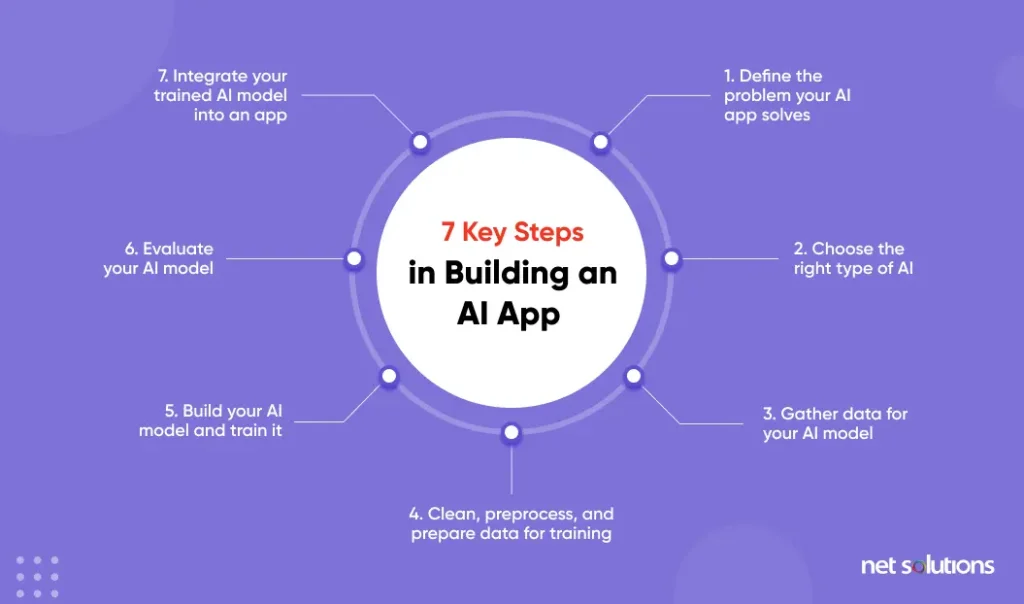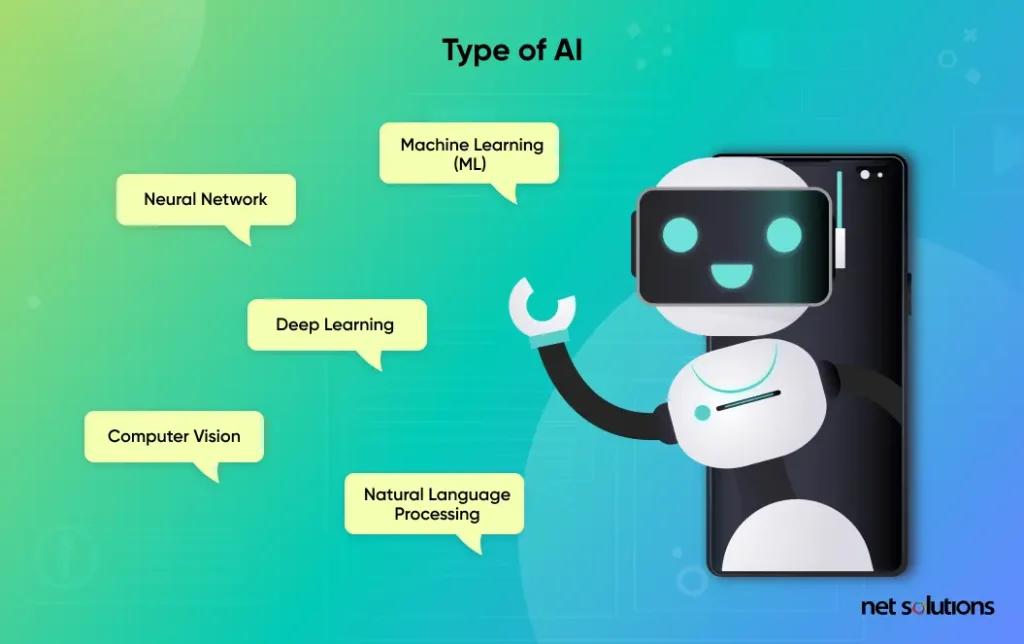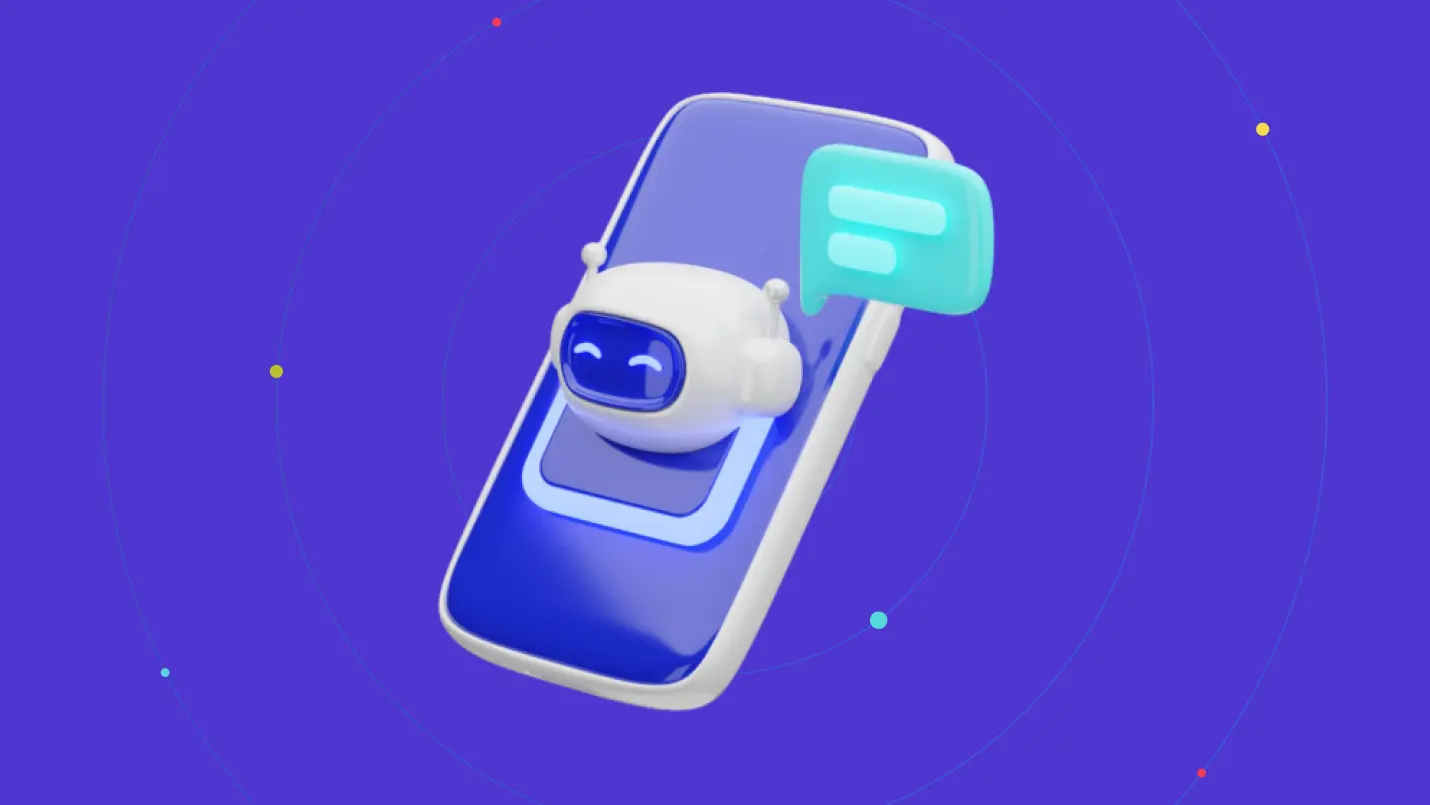We’ve reached a powerful turning point in the development of Artificial Intelligence, where the technology is so powerful and accessible that businesses large and small are engaging it for a vast array of use cases, from Machine Learning in EdTech to AI in the airline industry.
Non-technical companies and even legacy retailers are improving productivity, analyzing data, predicting market demand, managing supply chains, and transforming the retail shopping experience with AI. And with all the buzz around AI, you may wonder how to use it in internal and customer-facing applications.
We wrote this blog post as a general guide to answer your questions about AI app development, from the steps required to build it to the different types of AI technology you can employ.
Read on to learn how you can build an AI-powered app that will help your business grow and tap into new markets.
How Hard Is It to Develop an AI App?
All modern software development is a complex and multifaceted process, and developing AI-powered applications introduces an even greater layer of complexity for various reasons.
In addition to ordinary software development skills, building apps that draw from AI requires knowledge in the following areas.
- Machine Learning (ML) algorithms: ML is a specific AI use case, and those AI projects that require machine learning demand a deep understanding of how to build, train, and tune AI algorithms
- Data processing: AI must process very large data sets
- Complex testing: Testing for AI technology is often more complex than ordinary testing, requiring developers to validate accuracy and efficiency under a wide range of conditions.
- Advanced scalability: AI requires massive resources to run its calculations. Even with the power of cloud computing, scaling an AI app is more challenging than scaling an ordinary app.
- Legal and ethical considerations: AI technology like ChatGPT has raised concerns over intellectual property rights when drawing on the work of writers and artists. Beyond that, there are also questions about data privacy, job loss, and other concerns.
Working with AI technology requires a level of knowledge and expertise that goes beyond what’s typically expected of a full-stack software engineer. Anyone who wants to develop AI applications will need to hone their skills or consult an expert for guidance.
7 Key Steps in Building an AI App
Given the unique challenges posed by developing AI solutions, it only makes sense that development companies would approach AI-based app development differently than they approach ordinary apps. In this section, you’ll find an outline of the general steps required to build AI-driven software.

Make note of how much time AI developers spend on data-related activities as well as training and evaluation. Those are two of the most important items that distinguish AI development from ordinary software development.
1. Define the problem your AI app solves
Despite all our talk about all the differences between AI development and ordinary app development, the first step in developing any app is the same—finding a problem that software can solve.
Every app idea worth building, AI-driven or otherwise, must solve a problem that either your business or your potential customers need solved. To determine whether your AI app is worth building, ask yourself:
- Does the cost-benefit analysis add up? In other words, is it worth building this solution due to either market demand or the ability to improve internal business processes?
- Are there existing solutions that work reasonably well? If these solutions already exist, how will your AI solution improve upon what’s currently available?
- Is AI technology really necessary for this app? With all the buzz around AI these days, it may be tempting to build an AI solution even though one isn’t truly necessary. Given the extra work involved in AI development, ask yourself whether AI is actually necessary and adds something to the product.
Once you’ve identified a problem worth addressing through AI technology, you’ll need to decide which type of AI you want to use.
2. Choose the right type of AI
AI isn’t just one technology—it’s an umbrella term for many different technologies, each with its own benefits, capabilities, risks, and requirements.
When it comes to developing AI apps these days, developers are almost always creating some kind of generative AI app. Generally speaking, that refers to prediction or probability technology, rather than high-certainty decision-making.
Generative AI apps are relatively easier to develop than some of the more precise uses of AI we outline below, and they offer plenty of value. This makes them a top choice for developers.
Nevertheless, we wanted to provide a breakdown of all the different types AI technology available today and key concepts, from Machine Learning to Natural Language Processing (NLP). Keep in mind, however, that these technologies and concepts are interconnected in many ways. For example, an AI neural network facilitates deep learning, and deep learning is an advanced form of Machine Learning.
Choose the combination of technologies ideally suited to solving the problem you want to address.

Machine Learning: Machine Learning (ML) uses algorithms and statistical models to imitate the way the human mind learns. It draws connections between different data sets and makes predictions, gradually improving its accuracy over time.
Technologies that use Machine Learning include facial recognition, product recommendations, and predictive text.
Neural Network: A neural network, in AI terms, is a type of machine learning that draws its name from the way neurons interact with each other in our human brains. In simple terms, it uses interconnected “neurons” or nodes in a layered structure to identify patterns, verify predictions, and solve complex problems by learning from its mistakes.
Deep Learning: Deep learning takes ML to the next level by tapping into massive neural networks, with a mind-boggling number of interconnected processing units. This takes AI’s learning, analysis, and predictions to the next level.
A powerful example of deep learning is the advanced speech recognition technology we first witnessed in OpenAI’s GPT 4.0 (within the mobile app version).
Unlike previous generations of speech-to-text technology, you can speak to the app in a foreign language with a thick accent, and it will likely understand you. In fact, it can even understand what you’re saying if you make grammatical errors and mispronounce words, based on the errors other non-native speakers typically make.
Voice recognition has come a long way over the past decade. Remember when an earlier version of iOS’s Siri couldn’t understand Scottish accents?
Computer vision: Computer vision employs deep learning to recognize imagery captured by a camera. This type of AI processes, analyzes, and “understands” visual queues better and better with each new experiment and expanded data set. This technology is helping engineers perfect self-driving cars, security cameras, and much more.
Natural Language Processing: Natural Language Processing (NLP) is what we see in popular AI apps like OpenAI’s ChatGPT, where you can ask a question in a natural language like English, Mandarin, or Hindi, and the software produces a relevant response.
NLP and machine learning are the backbone of generative AI, and we’ll find its functionality used more and more in everyday technologies, such as AI chatbots, virtual assistants, and countless other use cases.
A whole range of technologies support these different types of AI, such as graphical processing units, advanced algorithms, APIs, and IoT technology, just to name a few. Be sure to acquire the necessary tech stack to support whichever AI technologies you require.
3. Gather data for your AI model
The old programming adage “garbage in, garbage out” is even more relevant today than ever before. AI draws on mountains of data, using carefully honed algorithms to optimize its decision-making over time. That means the value your software offers will be directly tied to the quality of your data and your data processing capabilities.
AI can draw its data from the internet, big data reserves, user interactions that train the software, and other sources. And as complicated as AI data collection gets, a very basic principle of data science is at work here. Namely, a large collection of diverse, representative samples will offer better insights and higher accuracy than a smaller, skewed data set.
Keep in mind the ethical and legal implications of gathering data from users and other sources. If you’re using customer data you’ve collected to make predictions, you should let them know about this and give them the chance to opt out. It’s not only the right thing to do, but failing to do so may risk violating data collection regulations like GDPR.
4. Clean, preprocess, and prepare data for training
When compiling your original training data for your AI-powered app, there are a number of steps you have to take to ensure it’s accurate and useful.
It would be impossible to include complete, step-by-step instructions for preparing training data in a guide like this—that’s something a data scientist can guide you through. However, we can provide a glimpse of what preprocessing data entails.
- Data cleaning: Collecting and extracting data can produce messy results, with duplicate entries, missing values, and other issues. Cleaning data addresses these types of issues so your data is uniform and readable.
- Data transformation: This step is about normalizing your data. For instance, if you’ve gathered customer satisfaction data that used a 1-5 scale and merged it with data that used a 1-10 scale, you need to normalize the results so they use the same scale.
- Data formatting: The software may require data to appear in a different format than the one you currently have.
- Text processing: If you’re using text-based prompts, then Natural Language Processing will come into play. You may have to break it down into keywords or phrases (known as tokenization) and eliminate common words that add no value.
- Outlier handling: Develop a system for detecting and handling outliers that will skew your data.
Keep in mind, we’re just scratching the surface here. Consult an expert for guidance if you have any questions about data preprocessing because good data is at the core of useful AI.
5. Build your AI model and train it
Now it’s time to build the AI model architecture you will use to train the AI that powers your app. An AI model architecture, in simple terms, is the blueprint AI will use to process and interpret your data. This means identifying layers, nodes (or neurons) for neural networks, inputs and outputs, and other core features.
When it comes to training your AI, you’ll need to choose a selection algorithm or learning model. In broad terms, there are three general categories of selection criteria that AI uses to understand and interpret data: Supervised learning, unsupervised learning, and semi-supervised learning.
Supervised learning involves labeling the data beforehand to coach the AI to understand what it’s reviewing and how to classify it. Unsupervised learning involves giving the AI unlabeled data, and then having it look for common traits and connections it will use to group and interpret the data. Semi-supervised learning is a fusion of the two approaches.
6. Evaluate your AI model
How does your AI model perform once you’ve initially trained it? It’s important to use objective metrics to evaluate its performance. That way you can refine your algorithms and improve not only its ability to perform a given task, but its capacity to learn from its mistakes and improve itself over time.
There are a number of metrics experts use to evaluate an AI model’s performance, and there’s simply no way we can do the subject justice in an introductory blog post. Instead, we’ll introduce you to three fundamental concepts in ML evaluation that will give you a taste of how data scientists evaluate AI performance: Precision, recall, and F-Score.
Please note, however, that even our preliminary discussion of these concepts is rudimentary—there is much, much more to these metrics, and the concepts they address, than we can cover here.
- Precision: Precision is a metric that evaluates accuracy. For example, if you created AI software to spot spam within a data set of emails, precision is a measure of how often the AI got it right, minimizing both false positives (non-spam marked as spam) and false negatives (spam marked as safe).
- Recall: Recall is a measure of sensitivity. In our spam example, picture a spam filter that reviews 10,000 emails and identifies 100 pieces of spam within that sample. Imagine that it accurately identified all the spam (high recall), but it also labeled 200 emails as spam that were NOT spam (false positives). This app has high recall, but it also has quite low precision.
- F-Score: F-Score is a complex formula that combines precision and recall into one metric. How it does this is beyond the scope of this discussion.
Based on what you want your software to accomplish, you will find yourself making decisions based on whether you want a higher tolerance for false negatives or false positives.
For example, imagine building software for a non-invasive medical device that screens for colon cancer risk in people under 50 (who don’t normally receive colonoscopies). Imagine that the software has a high recall (sensitivity), with a fair number of false positives and virtually no false negatives.
That could be an ideal scenario because a positive result would simply require a colonoscopy, which would uncover the true-positives and debunk the false-positives. That may be preferable to AI that has lower recall and higher precision, since the latter scenario would allow more false negatives to slip through (i.e., undetected cancer).
Again, precision, recall, and F-score are just a few of the metrics used to measure AI performance. Evaluating AI performance applies centuries of data science to a modern context, weighing numerous factors to reach a desired outcome.
7. Integrate your trained AI model into an app
Once you’ve trained your AI model and determined it to be initially effective at solving the problem you want your app to solve, it’s time to integrate it into the app. After all, the AI model itself won’t get you or your customers very far without a solid app and a usable front end.
When integrating an AI model into an app, pay attention to all the other factors you would normally pay attention to when building a non-AI-based Minimum Viable Product (MPV), including:
- User Interface (UI) and User Experience (UX) design informed by user research and testing
- Real-time processing capabilities
- Scalability
- Any necessary API integrations
- Meeting fundamental customer requirements
As with any other MVP, you’ll gain valuable information once you release your app into the wild. Based on customer feedback, you will revise your app and improve it in future releases.
How Much Does It Cost to Develop an AI App?
The costs required to build and release an AI-based app will vary considerably based on:
- The type of app you’re building
- What you’re trying to accomplish
- How many screens are involved
- Whether you’re using existing, open-source technology or building your AI model largely from scratch
- Countless additional factors
All these factors mean that costs could range anywhere from $20,000 to $500,000 or more, which is a gigantic range, we know! Don’t worry, though, we came up with a guide to estimate software development costs.
Adding AI technology to your app’s core functionality will naturally raise the cost, but how much it changes pricing will depend on how extensive the AI component is.
To accurately estimate the cost of creating an AI-based app, schedule a free consultation with one of our specialists here at Net Solutions.
Tools and Resources for AI App Development
The rapid growth and popular interest in AI in recent years means that software developers now have a number of tools at their disposal to aid them in the development process. Let’s briefly explore some of the tools and resources that can help you in your endeavors.
Programming languages
Ideal languages for AI programming are those that can process extremely large volumes of data. You’ll need to determine which languages work best for you, given your requirements and the skillset of your developers.
Some programming languages that work well for AI development include:
- Python
- Java
- C++
- Prolog
- Haskel
- Lisp
- Rust
- Smalltalk
Naturally, this list will vary based on the demands of your project.
Frameworks and libraries
Popular frameworks and libraries used in AI development include:
- Tensorflow
- CNTK
- AML
- SparkMLlib
- PyTorch
- Keras
- Core ML/Create ML
- Caffe2
- Scikit-learn
Data visualization tools
Popular data visualization tools used in AI development include:
- Tableau
- Microsoft Power BI
Things to Consider When Building an AI-Powered App
AI’s recent advancements are truly mind-blowing, and we can’t blame anyone for wanting to jump into AI development and explore its powers to analyze, predict, automate, and make our lives easier.
Before diving into development, however, you’ll want to consider the following questions. Explore and answer them to the best of your ability.
- Have you clearly identified a problem your business, or the market, needs solved?
- What solutions are currently available? What can you learn from them, and how do they fall short?
- Is AI truly the best solution for the problem you’ve identified?
- Are there any ethical or compliance issues you might encounter when building your AI app? Think in terms of data collection, privacy, intellectual property, and the existential fate of humanity. (We’re only sort of kidding about the last one!)
- Does your staff have the expertise to build an effective AI model, or should you hire an outsourcing team with AI development experience to guide you and handle key components?
All software projects require careful consideration because of the costs and risks involved. This includes opportunity costs since your staff could be working on other projects with higher ROI.
When it comes to AI-based development, the possible risks expand with this burgeoning technology. That said, the potential rewards expand as well, so if you see real potential there, don’t hesitate to explore it.
Need an AI App Development Partner?
Net Solutions is a full-service outsourcing firm with more than two decades of experience working with a wide range of companies, from startups to large organizations like IMG and the Harvard Business Review.
We’ve always been on the cutting edge of software engineering, and our AI developers can help you build an AI model designed to fuel the growth of your business. We also offer user research, UI and UX design, front-end and back-end development, QA testing, and full project management services.



